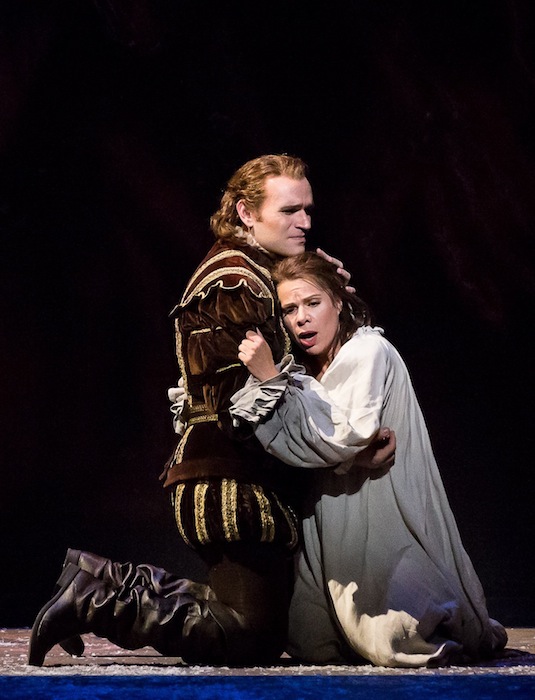Martinez’s powerful performance lifts Houston Grand Opera’s “Faust”

Michael Fabiano and Ana Maria Martinez in Gounod’s “Faust” at Houston Grand Opera. Photo: Lynn Lane
Roiling flames on the curtain greeted the audience Friday night. But the dramatic and musical fires didn’t ignite until halfway through Houston Grand Opera’s production of Faust — as passion and anguish gripped Marguerite, laid low by the devil’s cunning in Charles Gounod’s best-known work.
Ana Maria Martinez has treated HGO to heartfelt, compelling portrayals of Butterfly and Rusalka in recent seasons. She surpassed both on this opening night through the intensity she unleashed as Marguerite, the young woman seduced by the diabolically rejuvenated title character.
The glow Martinez brought Marguerite’s first scenes gave way to a vibrancy and power that captured the character’s remorse and rising desperation in the spinning-wheel aria. By the time Martinez’s abandon and soaring lyricism took flight in the electrifying final scene, Marguerite had long since become the opera’s emotional centerpiece.
The Puerto Rican soprano had ample help building this Faust to its climax, to be sure. The darkness and ferocity of the HGO Orchestra, as led by Antonino Fogliani, amplified Marguerite’s sufferings. Bass Luca Pisaroni’s snarling resonance put across Mephistopheles’ malevolence. When Marguerite’s brother, Valentin, denounced her for her sins, baritone Joshua Hopkins flung out the curses with ringing, relentless force. In the title role, tenor Michael Fabiano went beyond his previously sturdy vocalism to add an edge to Faust’s distressed contribution to the final trio.
Yet Martinez’s Marguerite was the most fully rounded and compelling character, as intended by the Francesca Zambello staging, here helmed by Garnett Bruce. By proceeding from the (sometimes cut) spinning-wheel aria to the aria for Marguerite’s admirer Siebel, the production kept the spotlight even longer on Marguerite’s emotions. And dropping the Walpurgisnacht scene, which serves little purpose other than supplying a ballet, eliminates the only part of the opera’s second half that moves the focus away from the heroine.
Though some Zambello stagings go too far in her own conceptual directions, this Faust plays out in the familiar, centuries-ago period. Faust and Mephistopheles wear doublets; a village fair features jugglers and acrobats; soldiers brandish swords; Marguerite resides in a humble cottage with a flower-filled garden. All this takes on a storybook charm thanks to sets and costumes designed by longtime Houston visual artist Earl Staley, who created the production with Zambello in the mid-1980s.
Amid the traditional components, though, Zambello has worked in some well-chosen inflections. After the verdant Garden Scene, she takes us to a grey winter setting of bare trees and a snow-dappled street, where Marguerite’s humiliations seem all the more grim. In an adroit coup de theatre, the street transforms before the audience’s eyes into the church where Marguerite suffers Mephistopheles’ torments.
For the big finish, Zambello and Staley have built a literal stairway to paradise: Marguerite, redeemed by heavenly mercy, ascends into billowing clouds and reaches out beatifically as the final chords sound. It may be a little hokey, but it certainly gives Faust a luminous ending.
Friday’s opening performance was slow off the ground. Making his HGO debut, Fabiano sang solidly, but his voice had no distinguishing features–gleam, warmth, whatever–to lend it character. In the opening scene, the elderly Faust’s unhappiness had no intensity; after the deal with the devil restored Faust’s youth, he didn’t sound particularly youthful, ardent or seductive. That left it to Fogliani and the orchestra to fill in some of the drama lacking from the tenor.
Pisaroni’s Mephistopheles cut a much livelier figure, musically and theatrically. For all the resonance he contributed to the climactic ensembles, Pisaroni at other times delivered the music with a lightness that let Mephistopheles’ sardonic humor shine. That helped propel the Garden Scence’s comic side as Pisaroni’s devil pretended to woo Marthe, Marguerite’s neighbor. Later, Pisaroni gave Mephistopheles’ ironic Serenade an etched-in-acid sharpness.
Hopkins’ ringing voice made him Pisaroni’s dueling equal in Valentin’s fatal confrontation with Mephistopheles. But in his first scene, as Valentine bade farewell to his sister before going to war, Hopkins didn’t complement that with much tenderness. In Valentin’s famously melodious aria, Hopkins sounded as fierce when he invoked his love for Marguerite as he did describing the glory of confronting the enemy.
Nicely turned supporting roles enhanced the story’s texture. Mezzo-soprano Margaret Lattimore made an exuberantly earthy Marthe. Baritone Ben Edquist played the student Wagner with youthful swagger. And mezzo-soprano Megan Mikailovna Samarin brought a vibrant voice and boyish energy to the pants role of Siebel. Unfortunately, Fogliani moved Siebel’s exuberant Garden Scene aria so briskly that some phrases could hardly register.
Fogliani also made the ballet waltz sound a little hell-bent, even though it had nothing to do with the devil. But in general he led a performance that balanced sweep and lyricism, with the polished HGO Chorus adding additional color. All of that made a sympathetic, powerful backdrop for Martinez’s commanding Marguerite.
Faust runs through Nov. 11. houstongrandopera.org; 713-228-6737.